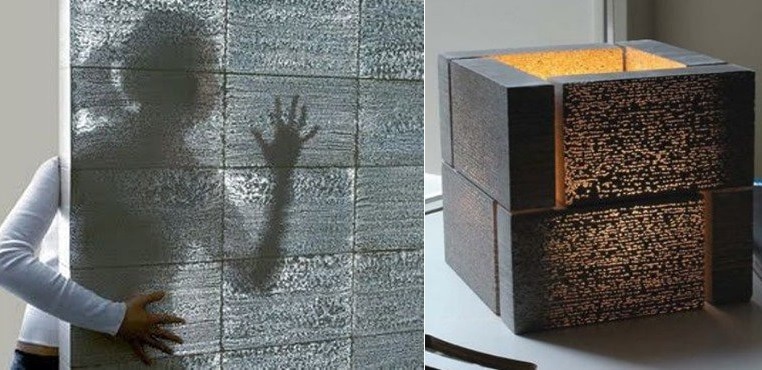Translucent concrete or light-transmitting concrete is a concrete-based building material with light-transmissive properties because of embedded light optical elements usually optical fibers. Light is conducted through the stone from one end to the other therefore, the fibers have to go through the whole object.
It is made of cement, sand, water, and optical fiber (2micro meters to 2 mm in size), which means that optical fibers are used in place of coarse aggregates.
Here we will learn about translucent concrete, advantages, disadvantages of light transmitting concrete & how to make transparent concrete!
Introduction to translucent concrete:
Translucent Concrete is also known as transparent concrete because it has light-transmitting properties due to the presence of optical fibers.
Fibres act as aggregates and carry light through them, flexible transparent fibres are made of glass or plastic.
These concrete works on “nano-optics”, the fibers are placed directly on top of each other.
Material used in translucent concrete:
Cement: Since optical fiber is responsible for the transmission of light, no special cement is required, therefore ordinary Portland cement is used for transparent concrete.
Sand: It is constructed using only fine materials; the size of the sand must pass through the sieve of 1.18 mm, the sand must be free from several impurities such as vegetation, large stones, etc.
Water: The water used should be of drinking quality and free from any impurities.
Optical fiber: Optical fibers in the amount of 4 to 5% are used for transparent concrete.
The thickness of optical fiber varies between 2 microns and 2 mm to outfit the exclusive necessities of light transmission.
Translucent concrete manufacturing process:
Step 1-Mold Preparation:
A mold of the rectangular cross-section 150 mm x 150 mm X 150 mm made up of wooden or metal.
For easy de-molding after concreting, place the optical fiber in the soil or soil besides the sides where the optical fibers are in contact with the frame.
Step 2- Optical Fiber:
The optical fiber rigorously reduces the required size of the mold.
The generally available diameters of optical fiber are 0.25 mm, 0.5 mm, 0.75 mm, 1 mm, and 2 mm.
Step 3- Fixing the fiber:
The fibers are placed either in an organic distribution or in a layered distribution.
The holes are operated on wooden or metal plates by which optical fibers are allowed to move.
Step 4 – Collapse:
The well-mixed translucent concrete is poured carefully and slowly so that there is no disturbance to the optical fiber already laid.
Concrete is filled in small or thin layers and stirred with the help of hill tables to avoid the void formation.
Step 5- Removing the mold:
After 24 hours, remove the mold and sludge, the molded mold is laid unattended on a flat platform.
Then, it is carefully removed after 24 hours of casting.
Immediately after de-molding, the cube samples had been marked by their respective identification marks/quantity (ID).
Step 6- Cutting and Polishing:
Cut the extra-long fibers, the same as the thickness of the panel.
Polish the panel surface using polishing paper or using sandpaper.

Advantages of Light Transmitting Concrete:
- The texture is visible, while the fine translucent concrete floor is slanted at some distance.
- When the concrete wall is allowed with the ability to transmit light, it means that homeowners can use less light in their homes throughout the day.
- It has excellent architectural qualities to give a stunning aesthetic view to the building.
- Where the light is not uniformly, transparent concrete can be used.
- Energy-saving can be achieved by using transparent concrete in the building.
- It is environmentally friendly due to its light-transmitting characteristics to reduce energy consumption.
Disadvantages of transparent concrete:
- This concrete is costly due to use of optical fiber.
- Casting of the transparent concrete blocks is complicated, so it mostly requires a skilled person.
Application of Translucent Concrete:
- These blocks are suitable for the floors, pavements, and load-bearing walls.
- Splitting walls based on facades, internal wall cladding, and thin panels.
- A partition wall can be utilized where daylight doesn’t reach properly.
- In furnishings for the decorative and aesthetic function.
- This COncrete used Light fixtures.
- It provides light pavement at night.
- It increases the visibility in dark metro stations
- In case of power failure, the light escapes from the indoor fire.
- Highlighting at night on roadways.
Also read: Glass fiber reinforced concrete (GFRC), Polymer Concrete & Fibre Reinforced Concrete
Conclusion:
This translucent concrete is developed by joining the optical fiber or large diameter glass fiber into the concrete mixture.
It has terrific light management properties and the ratio of optical fiber volume to concrete is proportional to transmission.
Also, it does not lose the strength as compared to regular concrete and also has aesthetically significant property.
This modern type of construction material can combine the concept of green energy and financial savings with the use of the self-sensing properties of functional materials.

Related Posts
Rock Quality Designation(RQD): Building Strong Foundations
Spread Footing
Masonry Cement
Plain Cement Concrete
Concrete Efflorescence
Concrete Pile
Stepped Footing
Fineness Modulus of Coarse Aggregates
Difference between Condo and Apartment